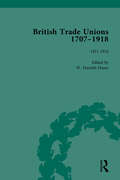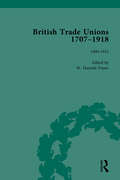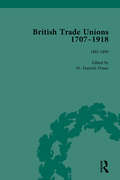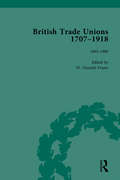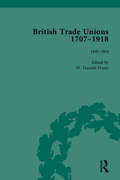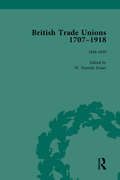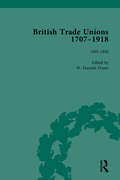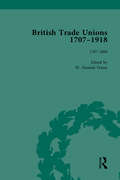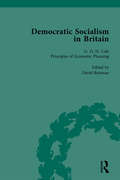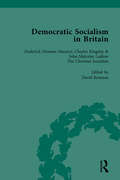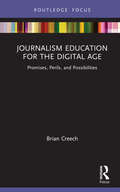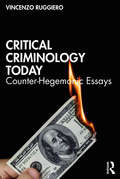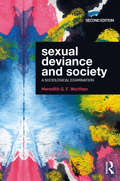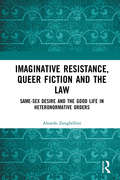- Table View
- List View
British Trade Unions, 1707-1918, Part II, Volume 8: 1912-1918
by W Hamish FraserDrawing from a variety of libraries and archives, this collection brings together material to illustrate the history of the development of trade unionism and industrial relations. It spans the period from the early journeymen's trade societies as they emerged in the 18th-Century through to the end of the First World War. This is the final volume of 8, Part II Vol 8 spans 1912-1918.
British Trade Unions, 1707-1918, Part II, Volume 7: 1900-1911
by W Hamish FraserDrawing from a variety of libraries and archives, this collection brings together material to illustrate the history of the development of trade unionism and industrial relations. It spans the period from the early journeymen's trade societies as they emerged in the 18th-Century through to the end of the First World War. Part II, Volume 7 spans 1900-1911.
British Trade Unions, 1707-1918, Part II, Volume 6: 1880-1899
by W Hamish FraserDrawing from a variety of libraries and archives, this collection brings together material to illustrate the history of the development of trade unionism and industrial relations. It spans the period from the early journeymen's trade societies as they emerged in the 18th-Century through to the end of the First World War. Part II, Volume 6 spans 1881-1899.
British Trade Unions, 1707-1918, Part II, Volume 5: 1865-1880
by W Hamish FraserDrawing from a variety of libraries and archives, this collection brings together material to illustrate the history of the development of trade unionism and industrial relations. It spans the period from the early journeymen's trade societies as they emerged in the 18th-Century through to the end of the First World War. Part II, Volume 5 spans 1865-1880.
British Trade Unions, 1707–1918, Part I, Volume 4: 1840-1864
by W Hamish FraserDrawing from a variety of libraries and archives, this collection brings together material to illustrate the history of the development of trade unionism and industrial relations. It spans the period from the early journeymen's trade societies as they emerged in the 18th-Century through to the end of the First World War. Part I, Volume 4 spans 1840-1864.
British Trade Unions, 1707–1918, Part I, Volume 3: 1826-1839
by W Hamish FraserDrawing from a variety of libraries and archives, this collection brings together material to illustrate the history of the development of trade unionism and industrial relations. It spans the period from the early journeymen's trade societies as they emerged in the 18th-Century through to the end of the First World War. Part I, Volume 3 spans 1826-1839.
British Trade Unions, 1707–1918, Part I, Volume 2: 1801-1826
by W Hamish FraserDrawing from a variety of libraries and archives, this collection brings together material to illustrate the history of the development of trade unionism and industrial relations. It spans the period from the early journeymen's trade societies as they emerged in the 18th-Century through to the end of the First World War. Part I, Volume 2 spans 1801-1826.
British Trade Unions, 1707–1918, Part I, Volume 1: 1707-1800
by W Hamish FraserDrawing from a variety of libraries and archives, this collection brings together material to illustrate the history of the development of trade unionism and industrial relations. It spans the period from the early journeymen's trade societies as they emerged in the 18th-Century through to the end of the First World War. Part I Volume 1 looks at 1707-1800.
Democratic Socialism in Britain, Vol. 7: Classic Texts in Economic and Political Thought, 1825-1952
by David ReismanThe texts in this collection of 10 volumes demonstrate both the diversity and continuity in British theories of democratic socialism. The selection encompasses the Ricardian socialists, the Christian socialists, and the Fabian socialists. Volume 7 includes ‘Principles of Economic Planning’ by G.D.H.Cole.
Democratic Socialism in Britain, Vol. 2: Classic Texts in Economic and Political Thought, 1825-1952
by David ReismanThe texts in this collection of 10 volumes demonstrate both the diversity and continuity in British theories of democratic socialism. The selection encompasses the Ricardian socialists, the Christian socialists, and the Fabian socialists. Volume 2 includes contributions from .Frederick Denison, Maurice Charles Kingsley and John Malcolm Ludlow, the ‘Christian Socialists’.
British Trade Unions, 1707-1918, Part II, Volume 8: 1912-1918
by W Hamish FraserDrawing from a variety of libraries and archives, this collection brings together material to illustrate the history of the development of trade unionism and industrial relations. It spans the period from the early journeymen's trade societies as they emerged in the 18th-Century through to the end of the First World War. This is the final volume of 8, Part II Vol 8 spans 1912-1918.
British Trade Unions, 1707-1918, Part II, Volume 7: 1900-1911
by W Hamish FraserDrawing from a variety of libraries and archives, this collection brings together material to illustrate the history of the development of trade unionism and industrial relations. It spans the period from the early journeymen's trade societies as they emerged in the 18th-Century through to the end of the First World War. Part II, Volume 7 spans 1900-1911.
British Trade Unions, 1707-1918, Part II, Volume 6: 1880-1899
by W Hamish FraserDrawing from a variety of libraries and archives, this collection brings together material to illustrate the history of the development of trade unionism and industrial relations. It spans the period from the early journeymen's trade societies as they emerged in the 18th-Century through to the end of the First World War. Part II, Volume 6 spans 1881-1899.
British Trade Unions, 1707-1918, Part II, Volume 5: 1865-1880
by W Hamish FraserDrawing from a variety of libraries and archives, this collection brings together material to illustrate the history of the development of trade unionism and industrial relations. It spans the period from the early journeymen's trade societies as they emerged in the 18th-Century through to the end of the First World War. Part II, Volume 5 spans 1865-1880.
British Trade Unions, 1707–1918, Part I, Volume 4: 1840-1864
by W Hamish FraserDrawing from a variety of libraries and archives, this collection brings together material to illustrate the history of the development of trade unionism and industrial relations. It spans the period from the early journeymen's trade societies as they emerged in the 18th-Century through to the end of the First World War. Part I, Volume 4 spans 1840-1864.
British Trade Unions, 1707–1918, Part I, Volume 3: 1826-1839
by W Hamish FraserDrawing from a variety of libraries and archives, this collection brings together material to illustrate the history of the development of trade unionism and industrial relations. It spans the period from the early journeymen's trade societies as they emerged in the 18th-Century through to the end of the First World War. Part I, Volume 3 spans 1826-1839.
British Trade Unions, 1707–1918, Part I, Volume 2: 1801-1826
by W Hamish FraserDrawing from a variety of libraries and archives, this collection brings together material to illustrate the history of the development of trade unionism and industrial relations. It spans the period from the early journeymen's trade societies as they emerged in the 18th-Century through to the end of the First World War. Part I, Volume 2 spans 1801-1826.
British Trade Unions, 1707–1918, Part I, Volume 1: 1707-1800
by W Hamish FraserDrawing from a variety of libraries and archives, this collection brings together material to illustrate the history of the development of trade unionism and industrial relations. It spans the period from the early journeymen's trade societies as they emerged in the 18th-Century through to the end of the First World War. Part I Volume 1 looks at 1707-1800.
Journalism Education for the Digital Age: Promises, Perils, and Possibilities (Disruptions)
by Brian CreechThis book examines pressing debates concerning how and why journalism education should respond to digital changes in and around the industry, and questions market oriented ideology and civic responsibility in the field. Surveying a broad field of discourse and research into journalism education, Creech shows how public ideals, market logics and industry concerns have come to animate discussions about digital journalism education and journalism’s future, and how academic structures and cultures are positioned as a key obstacle to attaining that future. The book examines labor conditions, critiques of journalism education as an institution, and curricular change, with reference to how conversations around race, fake news, and digital infrastructures impact the field. Creech argues for a critical pedagogy of journalism education, one that pushes beyond jobs training and instead is centred around a commitment to public and civic value via a liberal arts tradition made practicable for the digital age. This insightful book is vital reading for journalism educators and scholars, as well as journalists and news executives, education scholars, and program officers and decision-makers at journalism-adjacent foundations and think tanks.
Journalism Education for the Digital Age: Promises, Perils, and Possibilities (Disruptions)
by Brian CreechThis book examines pressing debates concerning how and why journalism education should respond to digital changes in and around the industry, and questions market oriented ideology and civic responsibility in the field. Surveying a broad field of discourse and research into journalism education, Creech shows how public ideals, market logics and industry concerns have come to animate discussions about digital journalism education and journalism’s future, and how academic structures and cultures are positioned as a key obstacle to attaining that future. The book examines labor conditions, critiques of journalism education as an institution, and curricular change, with reference to how conversations around race, fake news, and digital infrastructures impact the field. Creech argues for a critical pedagogy of journalism education, one that pushes beyond jobs training and instead is centred around a commitment to public and civic value via a liberal arts tradition made practicable for the digital age. This insightful book is vital reading for journalism educators and scholars, as well as journalists and news executives, education scholars, and program officers and decision-makers at journalism-adjacent foundations and think tanks.
Critical Criminology Today: Counter-Hegemonic Essays
by Vincenzo RuggieroWhat survives of the notions, principles and values of critical criminology? Faced with contexts that could not be more dramatically different to those fostering critical approaches to crime and its control, what is left of the radical theories and practical initiatives that characterized it in the 1970s? This book argues that critical criminology today can be reimagined if new concepts are elaborated, which bring academic efforts close to the practices of social movements. Building on an original collection of anti-hegemonic essays focused on specific criminological areas, including femicide, organized crime, drug use, punishment, state-corporate terrorism and financial crime, this book identifies the radical potential inherent in the choice of areas, topics and variables that critical criminologists can address today. In discussing concepts of distance, power, mercy and troublemaking, this book considers the relationship between critical criminology, social justice and activism. An accessible and compelling read, this book will appeal to all those engaged with critical criminology, sociology and cultural studies.
Critical Criminology Today: Counter-Hegemonic Essays
by Vincenzo RuggieroWhat survives of the notions, principles and values of critical criminology? Faced with contexts that could not be more dramatically different to those fostering critical approaches to crime and its control, what is left of the radical theories and practical initiatives that characterized it in the 1970s? This book argues that critical criminology today can be reimagined if new concepts are elaborated, which bring academic efforts close to the practices of social movements. Building on an original collection of anti-hegemonic essays focused on specific criminological areas, including femicide, organized crime, drug use, punishment, state-corporate terrorism and financial crime, this book identifies the radical potential inherent in the choice of areas, topics and variables that critical criminologists can address today. In discussing concepts of distance, power, mercy and troublemaking, this book considers the relationship between critical criminology, social justice and activism. An accessible and compelling read, this book will appeal to all those engaged with critical criminology, sociology and cultural studies.
Sexual Deviance and Society: A Sociological Examination
by Meredith G. WorthenIn a society where sexualized media has become background noise, we are frequently discouraged from frank and open discussions about sex and offered few tools for understanding sexual behaviors and sexualities that are perceived as being out of the norm. This book encourages readers to establish new ways of thinking about stigmatized people and behaviors and to think critically about gender, sex, sexuality, and sex crimes. Sexual Deviance and Society uses sociological theories of crime, deviance, gender, and sexuality to construct a framework for understanding sexual deviance. This book is divided into four units: Unit I, Sociology of Deviance and Sexuality, lays the foundation for understanding sex and sexuality through sociological frameworks of deviance. Unit II, Sexual Deviance, provides an in-depth dialogue to its readers about the sociological constructions of sexual deviance with a critical focus on contemporary and historical conceptualizations. Unit III, Deviant Sexual Acts, explores a variety of deviant sexual acts in detail, including sex in public, fetishes, and sex work. Unit IV, Sex Crimes and Criminals, examines rape and sexual assault, sex crimes against children, and societal responses to sex offenders and their treatment within the criminal justice system. This revised second edition includes new theoretical approaches such as Norm-Centered Stigma Theory; expands into new fields of criminology such as queer criminology; more deeply discusses nonbinary people’s experiences; includes updates to the landscape of LGBTQ rights; reviews "new" forms of sexual deviance including "incels" and "revenge porn"; covers the latest developments in the #MeToo movement; and expands on the discussion of SM, including the "Fifty Shades Phenomenon." In addition, this edition reviews the ever-evolving world of sex work and camming by examining how Pornhub, OnlyFans, and exotic dancers/strip clubs have revolutionized sex work during the COVID-19 pandemic. Utilizing an integrative approach that creates a dialogue between the subjects of gender/sexuality, criminology, and deviance, this book is a key resource for students interested in developing a critical understanding of sex, sexuality, and sex crime.
Sexual Deviance and Society: A Sociological Examination
by Meredith G. WorthenIn a society where sexualized media has become background noise, we are frequently discouraged from frank and open discussions about sex and offered few tools for understanding sexual behaviors and sexualities that are perceived as being out of the norm. This book encourages readers to establish new ways of thinking about stigmatized people and behaviors and to think critically about gender, sex, sexuality, and sex crimes. Sexual Deviance and Society uses sociological theories of crime, deviance, gender, and sexuality to construct a framework for understanding sexual deviance. This book is divided into four units: Unit I, Sociology of Deviance and Sexuality, lays the foundation for understanding sex and sexuality through sociological frameworks of deviance. Unit II, Sexual Deviance, provides an in-depth dialogue to its readers about the sociological constructions of sexual deviance with a critical focus on contemporary and historical conceptualizations. Unit III, Deviant Sexual Acts, explores a variety of deviant sexual acts in detail, including sex in public, fetishes, and sex work. Unit IV, Sex Crimes and Criminals, examines rape and sexual assault, sex crimes against children, and societal responses to sex offenders and their treatment within the criminal justice system. This revised second edition includes new theoretical approaches such as Norm-Centered Stigma Theory; expands into new fields of criminology such as queer criminology; more deeply discusses nonbinary people’s experiences; includes updates to the landscape of LGBTQ rights; reviews "new" forms of sexual deviance including "incels" and "revenge porn"; covers the latest developments in the #MeToo movement; and expands on the discussion of SM, including the "Fifty Shades Phenomenon." In addition, this edition reviews the ever-evolving world of sex work and camming by examining how Pornhub, OnlyFans, and exotic dancers/strip clubs have revolutionized sex work during the COVID-19 pandemic. Utilizing an integrative approach that creates a dialogue between the subjects of gender/sexuality, criminology, and deviance, this book is a key resource for students interested in developing a critical understanding of sex, sexuality, and sex crime.
Imaginative Resistance, Queer Fiction and the Law: Same-Sex Desire and the Good Life in Heteronormative Orders
by Aleardo ZanghelliniImaginative Resistance, Queer Fiction and the Law develops a novel account of how heteronormative sociolegal orders undermine the well-being of same-sex attracted people, even when these normative orders may fall short of coercively interfering with their choices. Queer well-being is generally studied from psychological perspectives, through the concept of ‘minority stress.’ Taking four texts of mid-century Anglo-American queer fiction as illustrative case studies, this book argues – in a philosophical rather than a psychological register – that heteronormativity also affects queer well-being in more intangible ways. The central claim is that heteronormativity shackles the imagination: it curtails no less the imaginative reach of authors of queer fiction, than our ability – engaged as we are in projects of self-authorship – to make-believe personal futures in which same-sex intimacy is brought to bear on our well-being. The book’s central claim re-works a concept central to the philosophy of fiction – ‘imaginative resistance’ – and puts it into service of questions raised in moral philosophy. Apart from its political and normative implications – strengthening the case for at least some global gay rights – and from challenging some of queer theory’s orthodoxies, the book also makes contributions to queer literary history, criticism and biography. Drawing on archival material and personal interviews, fresh readings are offered of Charles Jackson’s The Fall of Valor (1946), Gillian Freeman’s The Leather Boys (1961), and Patricia Highsmith’s The Price of Salt (1952) and The Talented Mr Ripley (1955), making a case for their inclusion in the queer literary canon. Imaginative Resistance, Queer Fiction and the Law will appeal to students of literary criticism, queer sociolegal history, law & literature, the philosophy of fiction, and queer theory, politics and ethics.
